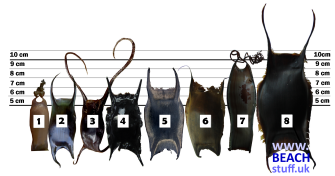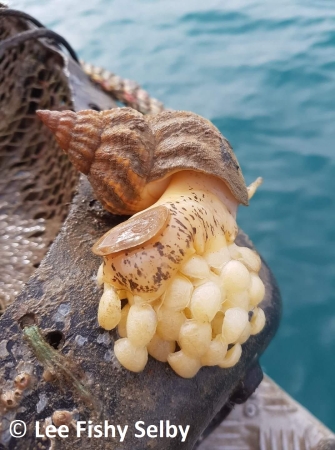


Some of the most peculiar things we find on the beach turn out to be eggs or empty egg cases. On this page, we have put together some of the common (and most weird) eggs to be found.
Scroll through to see them all, or skip to a type of egg:

Four dried egg cases, for scale - from left to right cat shark, nursehound, spotted ray, blonde ray.
Ray, Shark and Skate
egg cases
When a fish has emerged from its egg, the remains of the egg case often gets washed up onto our beaches.
Some of these egg cases may even have embryonic creatures still inside. If you can see a tiny shark or a tiny ray moving in cases like the ones on the left, take them to your local aquarium who may be very interested in seeing if they can be brought to the point of hatching.
For other fish, sea slug, sea hare, mollusc, squid, cuttlefish and all other eggs, scroll down...
Mermaid's purses
- ray egg cases
I assume that mermaids are now swiping their debit cards like the rest of us instead of carrying around bulky purses but, back in the day, it was thought they would use the egg cases of rays/skates for their coins. And presumably, after they'd spent up, they would simply throw their purses away which is why we find so many of them on our strandlines.
Spotted ray
This is the smallest of the ray egg cases found commonly in the UK.
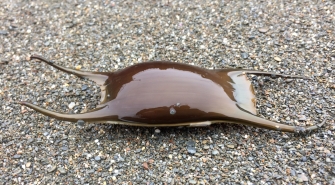
Undulate ray
A relatively 'stocky' egg case with short tendrils.

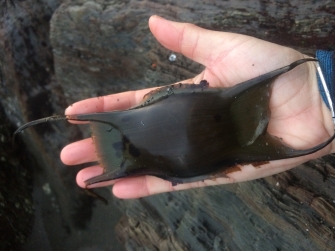
Blonde Ray
A significantly larger case than the spotted ray.
For scale (below), a spotted ray on the left, blonde on the right, with a nursehound egg case in the middle.

Thornback ray
This egg cases has distinctive 'frilled' sides.

Cuckoo ray
The cuckoo ray is a deeper water species and so its egg cases wash up relatively rarely. It has long, slightly curled tendrils.
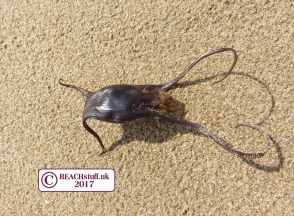

Flapper Skate
The flapper skate is the largest of the skates and has a suitably large egg case - around 25cm in length. In the UK, Flapper skates are generally only found in Scotland, most commonly around tghe Orkneys.
The fine example about was found by by Claire Richardson on the west coast of Scotland and has her size 5 foot for scale.
Shark eggs
Small spotted cat shark
Confusingly, this shark is also known as a lesser-
Sometimes, a bunch of cat shark egg cases will be washed up with their curly tendrils all tangled up together.

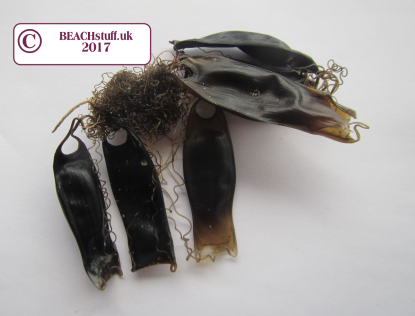
The egg case of a small-spotted catshark and that of a nursehound (described below) can look very similar with their curly tendrils and narrow shape. However, the catshark egg case is much smaller than that of the nursehoud.
The two photos below have the same hand, the same beach, but the top one is the small catshark, and the one below is the large nursehound.


Nursehound
This is generally a larger egg case - it still belongs to a type of shark but is three times the size of the small spotted catshark case (above), for example. It is often around 10-15 centimetres long (see above for a size comparison with the catshark eggcase)..
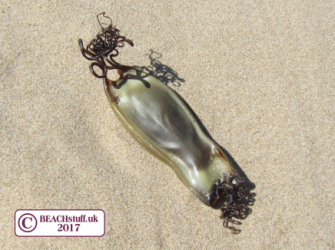
When I found the nursehound egg case below, the tiny little fish slipped out of it. It didn't look like it had been dead for long. I wonder what killed it when it was so nearly ready to emerge?

Whelk eggs
These balls of papery, veined, little eggs are whelk eggs, large, slow-moving sea snails that live in our waters. They have sometimes more orangey or beige than white depending on how old they are. By the time we see them on the strandline, the tiny snails have usually long-sinced hatched. Lee captured the whelk below in the act of laying her eggs. Thanks for the photo Lee!
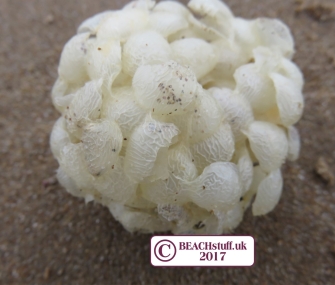
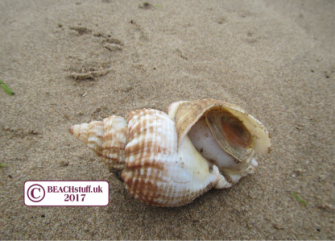
Sting Winkle eggs
These are small, flat papery upside-down heart-shaped eggs which, in number, look a bit like an eaten corn on the cob. On the left, they are stuck fast to razor clam shells although they have long since hatched. The sting winkle can be seen here.

Periwinkle eggs
Periwinkle eggs are often found attached to wrack seaweed.
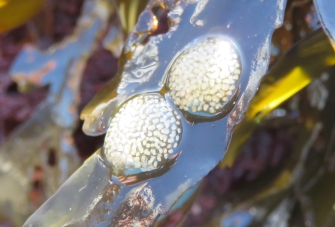
Netted Dog Whelk eggs
These can seemingly be laid on anything - like the Necklace Shell Skirt below.
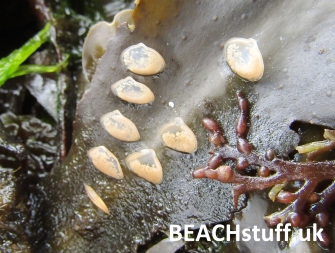
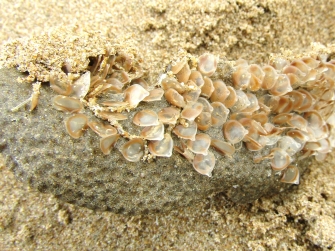
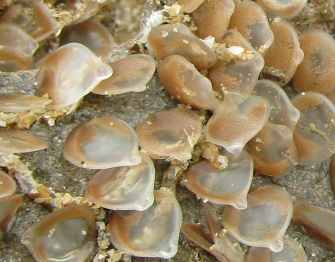
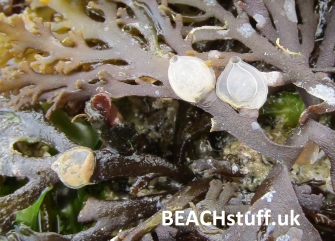
Egg skirt of a necklace shell
The necklace shell (also known as a moon snail) (pictured below), carries its eggs on a 'skirt' which is stuck all around the outside of the shell. The skirt itself, once it is picked up on the strandline, is like a thin dried leather material, generally still holding the shape it would have had when it encircled the parent's shell.
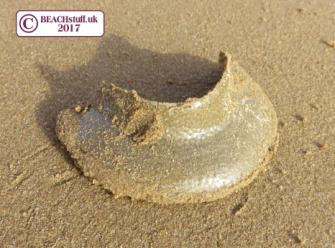
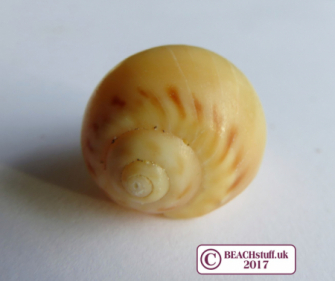
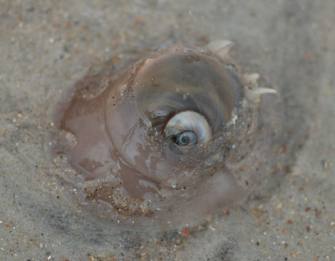
The photo on the right shows how the snail makes itself a skirt which is wrapped around the outside of the shell. The eggs are protected underneath it.
Source:Jarek Tuszyński,Wikimedia Commons. The licence.
Sea slug eggs / nudibranch eggs
As with sea slugs themselves, sea slug eggs come in all shapes and sizes. Have a look at this page for more.

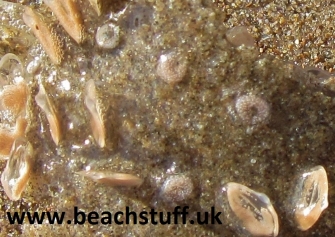
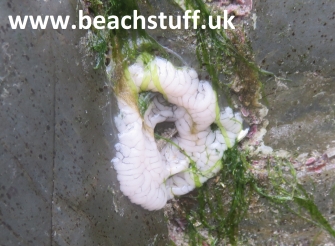
Sea Hare eggs
Like colourful strings of jelly spaghetti, sea hare eggs can often be found amongst the seaweed. For more, visit our page on sea hares.

Green Leaf Worm eggs
A soft green blob of eggs about the size of a penny. These worms are small slender paddle worm. More on green leaf worms here.
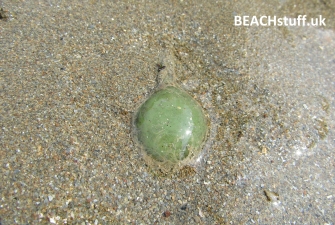
Bootlace Worm
Lineus longissimus
The long strings of eggs below were found and photographed by Robert Ward. Worm eggs are not always easy to identify but they do lookvery similar to Lineus sp. eggs and, as they were pictured by a bootlace worm, we strongly suspect that they could be Lineus longissimus. However, always very happy to be corrected! hello@beachstuff.
Thanks to Robert Ward for the photos.

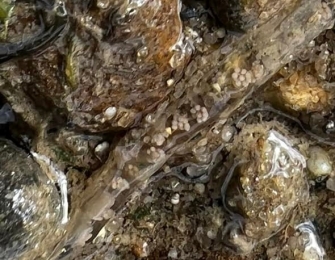
Lumpfish roe
This lump of tiny fish eggs (known as roe) is from a lumpfish. It looks just like a clump of old, dried up tapioca pudding. That reminds me - what's for tea?

Sand Goby eggs
The male goby stays with the eggs, which the female often lays inside shells, until they hatch.
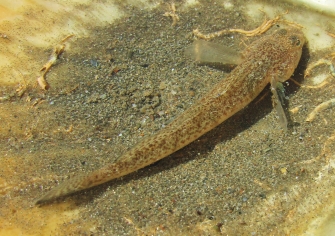

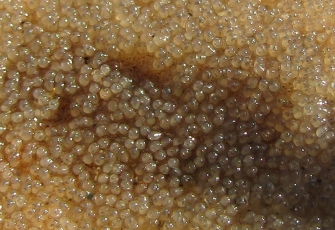
Blenny eggs
These tiny eggs - less than 1mm across - were on the underside of a flat stone exposed on the sand at low tide.
On the right hand side of the stone there is a small chiton which serves a little as scale.
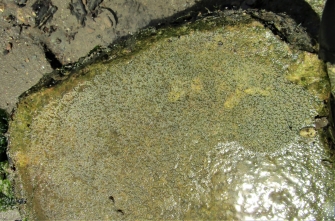
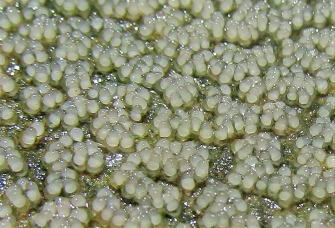
Sea Scorpion
These are the eggs of sea scorpions. These fish are quite common in UK waters although rarely seen. To see what the Sea Scorpion looks like (it's striking!), please go to this page.


It was only when I got home (the eggs were extemely tiny and I didn't have my glasses with me) and saw the photos on screen that I realised the paler eggs behind had eyes!

Squid eggs
Squid eggs can be washed up in masses looking a bit like a mop of soft stringy straws. The female does her best to lay her eggs (which she does thousands at a time) in safe places and anchor them to rocks but she doesn't stay with them and as they can take two months to hatch, storms can cause them to become detached. Once they are beached, they have no chance of survival.
For more on squids, have a look at our page on cephalopods.


| SQUID WATCH | 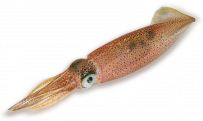 |
Follow a clutch of eggs as tiny squidlets hatch over a two week period.
Jump to this page for photos and video clips

Cuttlefish eggs
The female cuttlefish lays hundreds of eggs in the spring but dies very soon afterwards. The eggs can hatch anything up to two months after they have been laid depending, it would seem, on factors such as sea temperature.
For more on cuttlefish, have a look at our page on cephalopods.
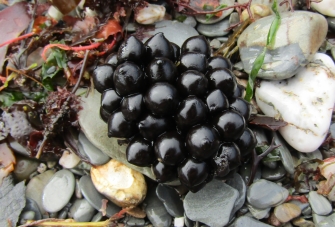
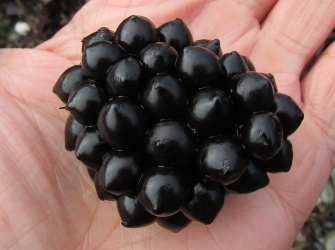
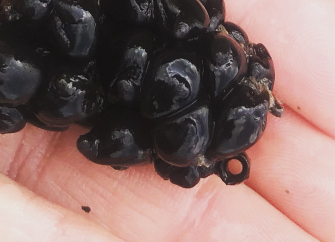
One clutch of eggs I found, had a perfectly formed natural hook on them through which there was the torn weed to which the eggs had been attached.
